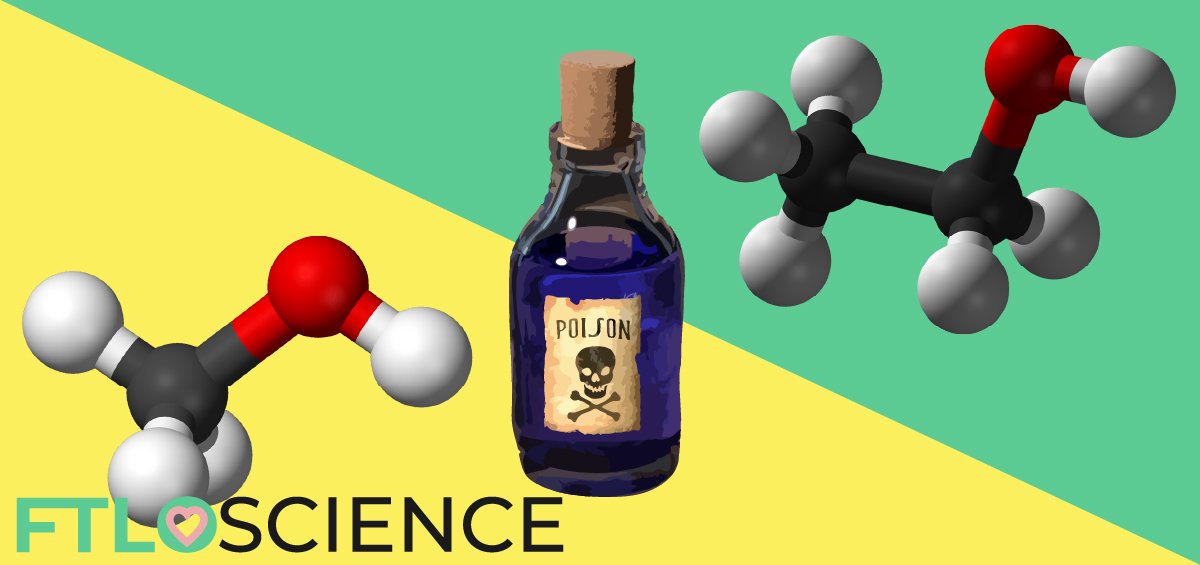Ethanol (alcohol) is a poison that is widely consumed all around the world. However, drinking methanol the same way leads to a different, irreversible kind of poisoning. We look at the chemistry and toxicity of ethanol and methanol, two very similar molecules that affect the body differently.
On its own, methanol toxicity is similar to ethanol (alcohol) toxicity. However, our liver breaks methanol down into deadly formic acid, a molecule that deprives our cells of oxygen. By the same process, ethanol is broken down into acetic acid (also known as vinegar), a much less toxic molecule. This is why methanol poisoning is a medical emergency.
How Methanol Gets into Our Alcohol
Homemade Liquor? Think Again
There have been many cases around the world of people experiencing methanol poisoning after consuming homemade or illegally sold alcoholic beverages.
This is a problem especially in developing countries where the sale of alcohol is banned. Bars often resort to creating their own, sometimes with disastrous results.
One of the dangers of consuming moonshine or bootleg liquor is the risk that it might have been spiked with methanol or that methanol has formed as a side product of improper fermentation.
Improper Fermentation
Alcohol can be created by yeast cells, a fungus that can undergo fermentation. In normal fermentation processes, yeast (similar to those used in baking) turns glucose sugar into ethanol (alcohol) and carbon dioxide:
\text{C}_{6}\text{H}_{12}\text{O}_{6} \to 2\: \text{C}_{2}\text{H}_{5}\text{OH} + 2\: \text{CO}_{2}Apart from glucose, many fruits used in making alcoholic beverages also contain pectin, another form of sugar. Pectin can be broken down into methanol, but not by typical yeast cells.
Only certain strains of wild yeast (yes, there are different yeast types) have a special enzyme called pectin methyl esterase, which breaks down the sugar to form deadly methanol.
Wild yeast is usually introduced into the fermentation containers through contamination, which is why commercial alcohol is produced in a regulated, sterile environment. Other beverages that are produced with the help of yeast, like kombucha, are also tightly controlled.
Methanol vs. Ethanol Toxicity
Methanol Poisoning
Very tiny amounts of methanol occur naturally in most alcoholic beverages without causing harm. However, illegally sold alcoholic drinks sometimes have methanol making up its entire alcohol content!
Drinking 10 ml of methanol is enough for its toxic effects to show, while ingesting 30 ml of more is often fatal.
Methanol poisoning can lead to severe health effects. Symptoms include slight intoxication (drunkenness) for 10 to 20 hours, followed by weakness, vomiting, pain, confusion, lowering of blood pH, blindness, coma and death1.
Methanol vs. Ethanol Toxicity
Methanol and ethanol are actually very similar in terms of toxicity. The methanol molecule is not very toxic, working the same way as ethanol to inhibit brain functions and give the drinker feelings of euphoria.
Our bodies, however, tend to break foreign chemicals down so they can be removed—a process known as metabolism. Although metabolism is meant to protect our bodies from toxic chemicals, methanol metabolism leads to the opposite effect.
Alcohol Metabolism
When we consume alcohols, it makes its way to our liver, where an enzyme called alcohol dehydrogenase breaks it down.
If the alcohol is ethanol, alcohol dehydrogenase breaks it down into acetaldehyde. If it is methanol, the enzymes metabolizes it into formaldehyde.
Both acetaldehyde and formaldehyde are known carcinogens (cause cancer), but they don’t usually pose an immediate danger to our health2.

Formic Acid, The Real Killer
The real toxicity associated with methanol poisoning comes from converting formaldehyde to formic acid in the next step of metabolism.
In the ethanol pathway, acetaldehyde is broken down into acetic acid, or vinegar. This non-toxic product is then excreted safely.
However, in the case of methanol, formaldehyde is converted into formic acid.

Formic acid (also known as formate) deprives cells of oxygen and causes them to die. The molecule inhibits a key enzyme in our mitochondria, cytochrome c oxidase, that is responsible for respiration.
By blocking the respiratory pathway, formic acid causes nerve damage, blindness and even death. Now we know that methanol poisoning should really be called formic acid poisoning!
Can Formic Acid Poisoning be Cured?
Fomepizole Treatment
The outcome of methanol poisoning (or rather, formic acid poisoning) can be good, but only if the patient receives treatment quickly.
However, because the initial symptoms are also caused by ethanol, people might not realize they are suffering from methanol poisoning, which delays treatment.
The cure for formic acid poisoning comes in the form of a drug called fomepizole. Fomepizole blocks alcohol dehydrogenase from functioning properly, stopping the breakdown of methanol into formaldehyde, which disrupts the pathway.
Hemodialysis—the filtering of blood by a machine—can also accelerate the removal of blood methanol and formic acid, although hemodialysis equipment is usually only available in large hospitals.
Ethanol to Displace Methanol
If it’s in an emergency situation and fomepizole isn’t available, the patient can be given ethanol. I know, it sounds crazy! But hear me out. Remember that ethanol and methanol are both broken down by alcohol dehydrogenase?
By flooding our liver with ethanol, we can force the alcohol dehydrogenase enzyme to break down ethanol instead of methanol, which blocks formaldehyde from forming. In this way, methanol is excreted via the kidneys before it can be converted into formaldehyde and formic acid!
Reference
- McMartin, K. E., Ambre, J. J., & Tephly, T. R. (1980). Methanol poisoning in human subjects: role for formic acid accumulation in the metabolic acidosis. The American journal of medicine, 68(3), 414-418.
- Kerns, W. D., Pavkov, K. L., Donofrio, D. J., Gralla, E. J., & Swenberg, J. A. (1983). Carcinogenicity of formaldehyde in rats and mice after long-term inhalation exposure. Cancer Research, 43(9), 4382-4392.
About the Author

Sean is a consultant for clients in the pharmaceutical industry and is an associate lecturer at La Trobe University, where unfortunate undergrads are subject to his ramblings on chemistry and pharmacology.




